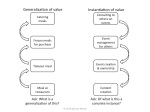Tuesday, July 1, 2014
One of the main challenges in business is finding a way to grow. A company can choose the acquisition route. This is what Richardson GMP did last year when it acquired Macquarie Private Wealth to become Canada?s largest independent (i.e. non-bank) wealth management firm. GE is currently in the process of acquiring France?s Alstom to expand its energy business, while Medtronic is buying Covidien to expand the range and scope of its medical device offerings.
In reality, though, an acquisition is just a means to an end. Companies can also choose to grow ?organically,? that is, to create new businesses from within on the basis of existing products and services. In either case, the growth can come from increasing its share and penetration of existing markets, offering new products to existing customers, seeking out new customers for existing products and services, or creating a whole new business by offering new products to entirely new customers.
There is a basic assumption underlying all of these approaches, however. It is that the company continues to define itself in the same way. If we take again the example of Medtronic, we can see that its acquisition of Covidien fits nicely within its corporate mission, which is: ?To contribute to human welfare by application of biomedical engineering in the research, design, manufacture, and sale of instruments or appliances that alleviate pain, restore health, and extend life.? (www.medtronic.com). Medtronic and Covidien both make surgical and prosthetic devices based on biomedical engineering.
But what if we go beyond the assumption of staying within an existing business model and mission? When I engage in strategy formulation with clients I often introduce the concepts illustrated in the following graphic. I call these complementary approaches generalization and instantiation of value.

Whenever a business has a very specific value proposition, I encourage its executives to question that by having them ask: What is this value an example of? Alternatively, what is a more general, abstract, or higher order way to express our value and mission?
In the diagram I show the process for a restaurant. The most concrete value that customers get is to go to the restaurant for a meal. But what if customers could get value by buying a meal there but taking it out to eat elsewhere? It is obvious that many restaurateurs and customers have already thought of that idea. You can go higher in terms of generality. What if customers could get meals from that restaurant but enjoy them whenever or wherever they want? Then you get a selection of frozen or preserved meals. The same goes for offering catering to clients of the restaurant. You can have any number of levels, but four levels are probably a good number to start with.
You can do this exercise in more ways than one. The restaurant owner could decide to generalize by opening other locations, or franchising, or getting into other types of cuisine, or restaurant formats. The important thing to remember is that you work from very specific and concrete value to a more general expression and form of the same value.
The right hand progression in the diagram is the inverse of generalization. Instead of generalizing upward, the object is to proceed downward from value that is very general and abstract to value that is more concrete. The question to ask, then, is whether you can provide a more concrete instantiation of the general value you are already providing.
The graphic depicts this instantiation process for a company that provides event management consulting to its clients. Through asking progressively more specific questions, the company could go from offering general consulting on events, to helping their clients organize and run their events, to co-owning events (e.g. a conference) with clients, or owning them outright. This could even extend to developing part or all of the content within the event, and then controlling the intellectual property and subsequent rights to it.
The important thing is to see this as a heuristic device to either expand or restrict your business? existing definition of value. This could even extend to redefining the company?s purpose by creating a new mission statement that is more specific and concrete, or more general and abstract.
© Alcera Consulting Inc. 2014. We encourage the sharing of this information and forwarding of this email with attribution. All other rights reserved.
This entry passed through the Full-Text RSS service — if this is your content and you're reading it on someone else's site, please read the FAQ at fivefilters.org/content-only/faq.php#publishers.